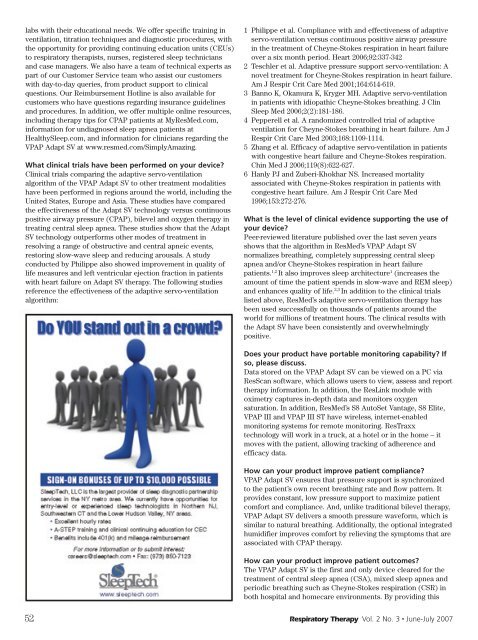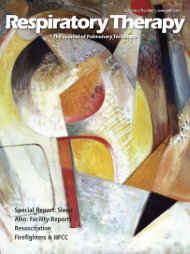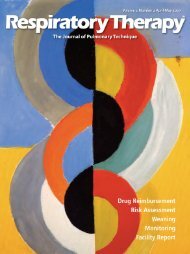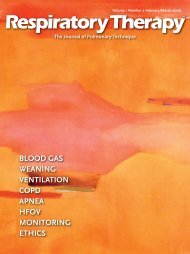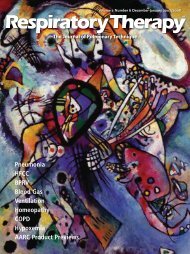RT 02-03 JJ07 main web - Respiratory Therapy Website
RT 02-03 JJ07 main web - Respiratory Therapy Website
RT 02-03 JJ07 main web - Respiratory Therapy Website
Create successful ePaper yourself
Turn your PDF publications into a flip-book with our unique Google optimized e-Paper software.
labs with their educational needs. We offer specific training in<br />
ventilation, titration techniques and diagnostic procedures, with<br />
the opportunity for providing continuing education units (CEUs)<br />
to respiratory therapists, nurses, registered sleep technicians<br />
and case managers. We also have a team of technical experts as<br />
part of our Customer Service team who assist our customers<br />
with day-to-day queries, from product support to clinical<br />
questions. Our Reimbursement Hotline is also available for<br />
customers who have questions regarding insurance guidelines<br />
and procedures. In addition, we offer multiple online resources,<br />
including therapy tips for CPAP patients at MyResMed.com,<br />
information for undiagnosed sleep apnea patients at<br />
HealthySleep.com, and information for clinicians regarding the<br />
VPAP Adapt SV at www.resmed.com/SimplyAmazing.<br />
What clinical trials have been performed on your device?<br />
Clinical trials comparing the adaptive servo-ventilation<br />
algorithm of the VPAP Adapt SV to other treatment modalities<br />
have been performed in regions around the world, including the<br />
United States, Europe and Asia. These studies have compared<br />
the effectiveness of the Adapt SV technology versus continuous<br />
positive airway pressure (CPAP), bilevel and oxygen therapy in<br />
treating central sleep apnea. These studies show that the Adapt<br />
SV technology outperforms other modes of treatment in<br />
resolving a range of obstructive and central apneic events,<br />
restoring slow-wave sleep and reducing arousals. A study<br />
conducted by Philippe also showed improvement in quality of<br />
life measures and left ventricular ejection fraction in patients<br />
with heart failure on Adapt SV therapy. The following studies<br />
reference the effectiveness of the adaptive servo-ventilation<br />
algorithm:<br />
1 Philippe et al. Compliance with and effectiveness of adaptive<br />
servo-ventilation versus continuous positive airway pressure<br />
in the treatment of Cheyne-Stokes respiration in heart failure<br />
over a six month period. Heart 2006;92:337-342<br />
2 Teschler et al. Adaptive pressure support servo-ventilation: A<br />
novel treatment for Cheyne-Stokes respiration in heart failure.<br />
Am J Respir Crit Care Med 2001;164:614-619.<br />
3 Banno K, Okamura K, Kryger MH. Adaptive servo-ventilation<br />
in patients with idiopathic Cheyne-Stokes breathing. J Clin<br />
Sleep Med 2006;2(2):181-186.<br />
4 Pepperell et al. A randomized controlled trial of adaptive<br />
ventilation for Cheyne-Stokes breathing in heart failure. Am J<br />
Respir Crit Care Med 20<strong>03</strong>;168:1109-1114.<br />
5 Zhang et al. Efficacy of adaptive servo-ventilation in patients<br />
with congestive heart failure and Cheyne-Stokes respiration.<br />
Chin Med J 2006;119(8):622-627.<br />
6 Hanly PJ and Zuberi-Khokhar NS. Increased mortality<br />
associated with Cheyne-Stokes respiration in patients with<br />
congestive heart failure. Am J Respir Crit Care Med<br />
1996;153:272-276.<br />
What is the level of clinical evidence supporting the use of<br />
your device?<br />
Peer-reviewed literature published over the last seven years<br />
shows that the algorithm in ResMed’s VPAP Adapt SV<br />
normalizes breathing, completely suppressing central sleep<br />
apnea and/or Cheyne-Stokes respiration in heart failure<br />
patients. 1,2 It also improves sleep architecture 1 (increases the<br />
amount of time the patient spends in slow-wave and REM sleep)<br />
and enhances quality of life. 2,3 In addition to the clinical trials<br />
listed above, ResMed’s adaptive servo-ventilation therapy has<br />
been used successfully on thousands of patients around the<br />
world for millions of treatment hours. The clinical results with<br />
the Adapt SV have been consistently and overwhelmingly<br />
positive.<br />
Does your product have portable monitoring capability? If<br />
so, please discuss.<br />
Data stored on the VPAP Adapt SV can be viewed on a PC via<br />
ResScan software, which allows users to view, assess and report<br />
therapy information. In addition, the ResLink module with<br />
oximetry captures in-depth data and monitors oxygen<br />
saturation. In addition, ResMed’s S8 AutoSet Vantage, S8 Elite,<br />
VPAP III and VPAP III ST have wireless, internet-enabled<br />
monitoring systems for remote monitoring. ResTraxx<br />
technology will work in a truck, at a hotel or in the home – it<br />
moves with the patient, allowing tracking of adherence and<br />
efficacy data.<br />
How can your product improve patient compliance?<br />
VPAP Adapt SV ensures that pressure support is synchronized<br />
to the patient’s own recent breathing rate and flow pattern. It<br />
provides constant, low pressure support to maximize patient<br />
comfort and compliance. And, unlike traditional bilevel therapy,<br />
VPAP Adapt SV delivers a smooth pressure waveform, which is<br />
similar to natural breathing. Additionally, the optional integrated<br />
humidifier improves comfort by relieving the symptoms that are<br />
associated with CPAP therapy.<br />
How can your product improve patient outcomes?<br />
The VPAP Adapt SV is the first and only device cleared for the<br />
treatment of central sleep apnea (CSA), mixed sleep apnea and<br />
periodic breathing such as Cheyne-Stokes respiration (CSR) in<br />
both hospital and homecare environments. By providing this<br />
52 <strong>Respiratory</strong> <strong>Therapy</strong> Vol. 2 No. 3 � June-July 2007


